Figure 4.1 Key to Geneograms
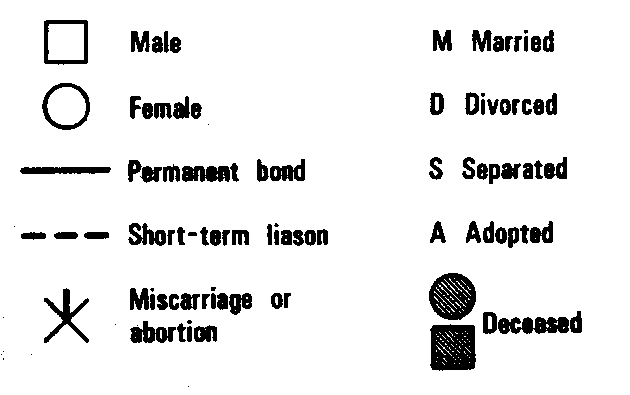
I keep six honest serving-men,
(They taught me all I knew)
Their names are What and Where and When
And How and Why and Who.
R. Kipling, Just So Stories
A geneogram is a visual diagram of family relatedness, structure and history. It combines the usual demographic date such as age, sex and marital status with the dates of important life events such as births, marriages, divorces, and deaths. The geneogram also graphically represents the skeletal relationship structure of two or more generations of a family upon which their collisions, patterns, bonds, and the transgenerational passage of their culture may be superimposed.
The geneogram is more than a standard geneologic device or family tree. Although it does contain the usual information about the ancestry of individuals and their families, it also serves to depict the important relationship structures and patterns both past and present. It is the equivalent of a family life chart both as the family now exists, as it existed in the past and through speculation as it will or might exist in the future.
Although the geneogram is fairly widely used by family therapists, few articles have been written giving details of the rationale for its useNote 1 or the method of its construction. The paucity of articles may relate to the difficulty in describing an ongoing visual and dynamic process in the static medium of printed words.
Gathering information is only one of the many functions of the geneogram. For example, the geneogram functions as an educational tool. It can educate the family into an organic view of itself, provide a rationale for changes in secrecy boundaries between family members, and allows a working blueprint for change to be explained clearly to the family involved. The process of construction within the session can engage all family members in a common task, neutralise destructive conflicts temporarily and bridge intergenerational barriers. The geneogram also allows the therapist a quick and thorough entry into the family's cultural development, tradition, and belief, enabling the therapist to make sense out of the gestalt of those family members present in the therapy session. Finally the geneogram provides a neutral task which may relieve the anxiety of a new therapist when confronting the
<end of page 68>
unknown, possibly hostile or engulfing family.
The geneogram may be constructed on a blackboard in the office in the presence of one or more family members, or it may be drawn by each family member on paper once the symbols used in its construction have been explained. After having been taught the means of construction of a geneogram family members can be asked to construct their own diagrams at home. In this way they can gather information from sources in their family at home to fill in missing data about their family.

The symbols used in the construction of a geneogram are shown in Figure 4.1. These simple symbols can be used to build up a picture of the most complex family structures. A solid line (______) between a circle and a square indicates along-term union, either a marriage or a longstanding relationship such as common-law marriage. It is a symbol indicating that heterosexual bonding has been established. A broken line (------) between a circle and a square indicated a short-term sexual liaison, such as an affair which may be included because of its importance to the development of the family quandary. A line descending from the union between a man and a woman, whether a marriage (solid line) or an affair (broken line) indicates the offspring or issue of that relationship. Children are usually listed in order of birth date from left to right, including miscarriages, and are joined on a solid horizontal line if they are full siblings. Full names may be written above each of the circles and squares and ages may be written within them. Marriage dates are written above the union line while dates of separation and divorce are written immediately below the union line.
<end of page 69>
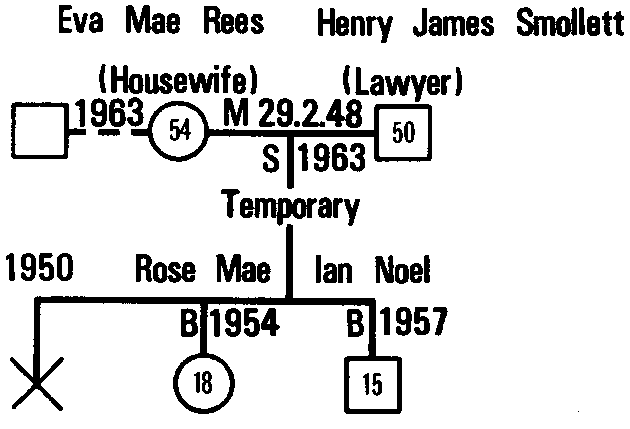
Figure 4.2 is a visual representation of a nuclear family. The geneogram at its present stage reveals that Mrs. Eva Mae (Rees) Smollett, a 54-year old housewife, married a lawyer, Henry James Smollett, on the 29 February 1948. Following a miscarriage in 1950, they produced a daughter in 1954 named Rose Mae, and a son, Ian Noel, in 1957. Seven years later, in 1963, Eva had an affair with an unnamed man and separated from her husband. The separation was temporary. So far the geneogram depicts a two-generational family structure whose fourth-dimensional origin occurred with the marital bond in 1948. That bond was stressed by an affair and temporary separation in 1963.
Figure 4.3 continues the geneogram construction further back in time and into the extended family including grandparents, uncles, aunts, and cousins. Arthur Michael Rees, a farmer, and Rose Mae married in 1922. They had three children, Kevin, Neal and Eva Mae. Their respective ages at the time of the interview were sixty, fifty-eight and fifty-four. Neither Kevin nor Neal married. Arthur Rees died in 1963 while Rose Mae died in 1967. George Smollett, a lawyer, married his wife, Rose in 1919. They had two children, George Andrew, fifty-eight, and Henry James. For convenience the convention of listing offspring by date of birth from left to right has been ignored in order to show the combination of the two families of origin at the time of marriage. The ages within the circles or squares and the dates of birth give enough
<end of page 70>
<Page 71 is entirely composed of figure 4.3 in Landscape orientiation>
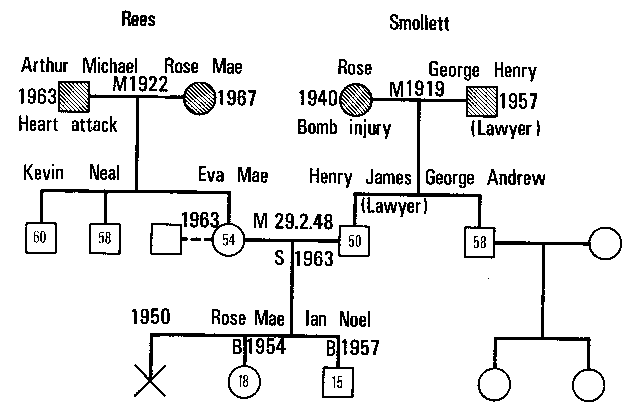
A comparison of the foregoing diagrams with their written explanations should clarify the usefulness of drawing out the family structure rather than writing it down. The organised visual display depicts relationships with an overview lacking in the verbal description.
Up to this point the family diagrammed has been a relatively simple one. There are families whose complexities can tax the imagination in attempting to record their geneogram. Three of the most common complexities are reconstituted families, multiple births, and adoption. The geneogram can be of special use in recording reconstituted families. The therapist can clearly delineate the origin of each of the various children in the family to himself as well as to the family members who may never have encountered such a factual display of the structural anomalies in their family.
Figure 4.4 shows all of the previously mentioned complexities in one geneogram. The family is actually a composite of several families. June and David Rudge were married in 1950 and produced three children, Joan, and twins Simon and Justin. The twins are represented on a separate vertical line branching into two further vertical lines. That they are twins should be clear from their single date of birth as well as their equal ages. David Rudge died in 1955 in a car accident. June remarried in 1960 to Barry Hamblin. Barry had been previously married from 1958 to Heather who was pregnant with Margaret prior to marriage. On his divorce in 1960, in which June was "the other woman", he remarried to June. Heather remarried in 1965 to Mark Sutcliffe who was fifteen years older than she. Heather had again been pregnant prior to marriage. She gave birth to John in 1966 and three years later gave birth to Josie, now a ten-year-old mentally subnormal child. June and Barry found that they couldn't have children so they adopted Dora in 1970. Mark Sutcliffe adopted his stepdaughter, Margaret, in 1970. Margaret married in 1978. In this composite family it would be possible to imagine that Margaret and her husband were referred for marital problems and that Margaret still maintained relationships with all of her relatives. It should be clear from the geneogram that there are solutions to drawing the most tangled of family relationships.
<end of page 72>
<Page 73 is entirely composed of Figure 4.4 in landscape orientation>

So far my description has been limited to the mechanics of constructing a geneogram. This description has been necessary in order to convey to the reader the methods of recording, but has not yet dealt with the dynamic construction process.
The production of the geneogram is a process in which the family members and the therapist must co-operate. The process is complex and may involve a lengthy interaction between the family members, the therapist and the diagram being constructed. It is within that process that the geneogram ceases to be a sterile shorthand of history and relatedness. It becomes instead a tool used to explore the family quandary, its origins and its possible solutions.
Here I feel it necessary to insert a detailed clinical example of the process of geneogram construction in order to illustrate its complexities. In the following transcript I have eliminated extraneous material but have kept the temporal order of all the interactions between the family members, the diagram and myself. This was the first family therapy session of the Slater family. They were referred to me after the identified patient had been discharged from an in-patient unit following her refusal to co-operate with the treatment offered to her. The geneogram was used to build the family structure in front of the family on a blackboard, involving all of them in the process. The initial tone of the session was one of anger and frustration. The family members felt that the psychiatric services had rejected them and that their referral to me was one of measured desperation.
Diagrams of the geneogram being constructed have been placed at appropriate intervals within the transcript in order to show its build up throughout the session.
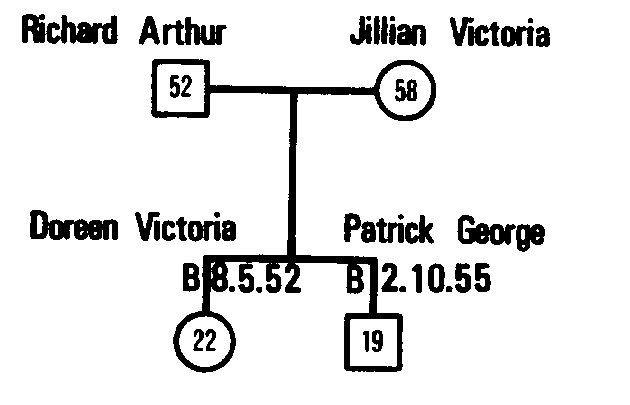
(Laughter)
<All of page 77 taken up with figures 4.6 and 4.7 one above another, portrait>
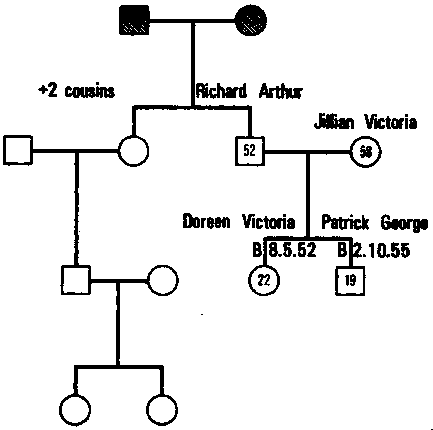
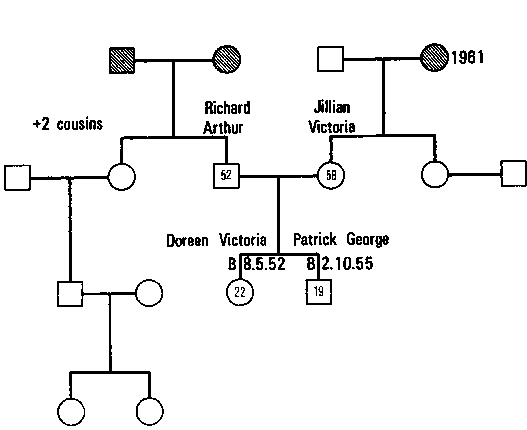
(Silence)
(Laughter all round)
(Roars of laughter)
do until they get married and go away.
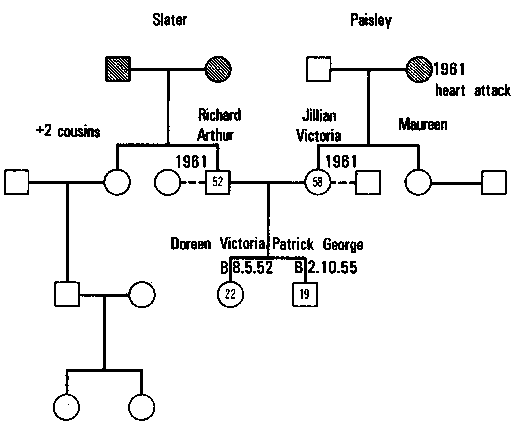

In the process of building the geneogram in front of the Slater family several simultaneous aims were achieved. The anger and tension present at the beginning of the session were replaced by a feeling of involvement and engagement. I was able to concentrate on the family's development and history instead of being drawn into a sterile discussion about the treatment of anorexia nervosa. There was a stimulation of shared emotional closeness between all the family members and in that sharing some of the secrecy in the family between the two generations was breached. Most important the family quandary was separated from the individual illness. The family quandary involved fundamental and long-lasting conflicts between Mr. and Mrs. Slater which were themselves based in the influences from previous generations. Their marriage incorporated the socio-cultural differences between the Irish and the English. The individual family cultures added a matriarchal versus patriarchal conflict to the family collision when they were married. The death of Mr. Slater's mother was followed by her replacement through the conception and birth of their daughter. The death of Mrs. Slater's mother occurred in the midst of the dissolution of their marriage. Mr. Slater ended his affair and rushed back to his family but the damage was done. Mrs. Slater blamed her husband for her mother's death and she lost all feeling for him gradually over the remaining years. Yet her loss of feeling was only part of the picture since she needed her husband as a person whom she could continuously hold responsible for her mother's death. She continued sexual relations with her husband until her menopause. Her daughter was unhappy but trapped at home. She was very sensitive to the tension at home but unlike her brother she could not leave. The illness she developed was an individual response to the tension. By the end of the session
<end of page 85>
the illness was placed in a proper perspective. Mr. and Mrs. Slater were later seen in joint marital sessions and their daughter returned for several conjoint sessions. She gained weight although remaining below her target weight and became much less sensitive to her parents' arguments. She eventually moved away from home in pursuit of her own career as a dress designer.
I have attempted to describe the way in which the geneogram construction process combined history-taking with the interactions between family members and therapist throughout the session. It is this process and its exploitation as a tool which opens the way to the analysis of a family quandary and the planning of therapeutic tasks and techniques which aim at the resolution of the quandary.
There are requirements for enquiring into fine details in a geneogram which arise from four major therapeutic purposes. The first of these purposes is to distinguish fact from fantasy accurately and clearly in order to establish the life history of a family. The structural skeleton of the family provided by the geneogram must be combined with a chronological skeleton, a 'life chart' of the important events in family life.
One of the shortcomings of the human memory is its inability to record dates infallibly and order events in their correct time sequence. Full names, ages, dates of birth, adoption, separation, divorce, marriage, and death are all chronological landmarks to a family whose members each argue the case for the accuracy of their recall of detail. The exact dates can be determined through the use of corroborative accounts from the various family members interviewed together or separately. Written corroboration is often available from documents such as birth certificates which families store but to which they seldom refer. Chronological landmarks can settle fractious and divisive arguments about fact. These arguments are used by family members in the family sessions to avoid painful emotional issues. Comparison of previously-held but erroneous beliefs about the chronology of family life events given access to painfully felt emotion and conflicts between family members which seemed to originate in arguments over fact. The establishment of chronological framework provides the skeleton upon which the muscle of powerful fantasies may be successfully explored.
The second purpose for detailed enquiry relates to the natural avoidance of emotional displays by family members. By encouraging families to bring to the surface their painful feelings, such as anger, sorrow, jealousy, mistrust or hatred, and unload them in the family therapy sess-
<end of page 86>
ions without first having established a framework of events to which these feelings have been attached, a therapist may feel stranded in an unknown swamp and may sink in the resulting quagmire of emotions as a result. But if the therapist sinks, so too does the family. Most families, if given the chance, will avoid the expression of painful or unpleasant feelings. This avoidance can also engulf the therapist. A detailed enquiry into the family's developmental history will allow a controlled exploration of those events which arouse strong feelings. The empathic therapist will already be alerted to those areas of avoidance before the emotions crest like a tsunami to pour into the session in an uncontrolled and destructive form.
There is an example of this ability to control and direct the display of emotions in the Slater transcript. The death of Mrs. Slater's mother was an area which I sensed would be emotionally explosive. I postponed exploration but later returned to it. It was at that point in the interview that the pent-up feelings of anger and sadness which were present in much of the session were finally connected with the course of events which seemed to have precipitated them. The family members were by then aware that I would continue drawing the geneogram and that there was no point in 'beating about the bush'. The controlled result of this detailed enquiry eventually provided the entire family with an understanding that the marital subsystem required help and was the major cause of the family quandary.
The third purpose of detailed enquiry comes in dealing with the continuum of secrecy within a family. I have often encountered the truth about premarital pregnancies, affairs, abortions, adoptions, and other, more terrible secret material during the process of neutral but direct enquiry about exact dates, numbers of pregnancies, medical histories or legal involvements. Since these secrets are not known by all family members present in conjoint sessions, unresolved conflicting statements, professed ignorance, or embarrassed silence may be the first indication that there is a secret present. Geneograms may actually have to be done separately with suspect family members if it is clear that certain detailed information has been deliberately withheld in a conjoint session. It is important to note the vague feelings of disquiet or reluctant eye contact that occur when detailed enquiry is poised on the threshold of an area of secrecy. One family which I visited at home chose such moments to bring out the tea and biscuits.
Finally, a detailed enquiry serves the purpose of thorough exploration of the family culture and the connection of collision of family cultures to the family quandary. The family usually appears in the session
<end of page 87>
presenting a quandary which is unconnected to the manner in which the family's culture has conveyed the family to their present dilemma. Often, no illness in the family surfaced directly from their quandary; instead it appeared like Athena, born full-grown from the head of Zeus (that Zeus swallowed his mother whole who then delivered her within him carries this metaphor to its logical conclusion).
The connection of the quandary to the family culture is illustrated in the family which was referred with a ten-year-old boy with a travel phobia. His father seemed puzzlingly over-protective and treated his robust son as a delicate and precious specimen. Father's first statement that he himself was an only child had been accepted until in a later geneogram session he revealed that his mother lost four previous children by miscarriage or stillbirth. He was very precious to his parents and was treated as such. This pattern of child-rearing was brought by him into his marriage and conveyed to his child despite the very altered circumstances of the family.
The geneogram is a tool which provides both overt and covert uses. Any tool requires knowledge, skill and practice before it can be used to its best potential. Knowledge and skill can come with practice but as any amateur do-it-yourself craftsman can testify, the initial results may not seem worth the effort. The geneogram is a tool whose uses increase with practice. The therapist who has gained skill in its use may find it a therapeutic method in itself.
The first open use of the geneogram is to enable a therapist to systematically take a history in a thorough and neutral (non-partisan) manner within the family session. Traditionally doctors have relied heavily on history-taking as providing 75 per cent of the necessary information required for diagnostic purposes. There is no reason to suppose that this contribution should be any less in exploring and diagnosing a family quandary. In this history-taking process the therapist questions the family members about their names, siblings, parents, dates of birth and son on, all of which are recorded. The information gathered builds a family tree while nodal points of family additions and losses are noted, and any areas of conflict or missing information are explored further. As a history-taking tool the geneogram is as useful as the therapist employing it is skilful.
The history-taking process logically extends to use of the geneogram as an educational aid. The family must be apprised of the basic premise of family therapy; that the family is an organism. To family members
<end of page 88>
labelled with an individual illness such as depression, agoraphobia or frigidity, this concept is an alien one which must be taught. The interlinked structure of a geneogram provides a lucid illustration of the family organism. The family educational process can then proceed to the transgenerational model of the family organism possessing the fourth dimension of time. Repetitive patterns which are visible in the geneogram structure from generation to generation can illustrate this point. In fact, most of the concepts applying to family therapy can be usefully taught to families using the geneogram which has been drawn on a blackboard in front of the family during the session.
One further overt use of the geneogram as a tool is seen in its ability to pick out solutions to the family quandary based on similar solutions which have come to light through the exploration of extended family patterns. Many of the quandaries which have brought a particular family to therapy have been encountered and mastered in parts of the extended family without professional guidance. The geneogram is used to explore the diversity of extended family repertoires. A client family will see the solution to their quandary as much more natural if it has been planned on the model existing within their own family's experience. Blueprints for change in the client family are planned with them and gain their acceptance more readily if the change required is one which they already experienced vicariously in their uncle's nuclear family or in the nuclear family of one of their cousins.
The uses of the geneogram already mentioned can combine to provide a self-contained therapeutic method in and of itself. The following example illustrates this use on an individual patient.
Mrs. Lewis was referred suffering from unremitting bouts of depression following a second marriage. Crying spells, sleep disturbance and loss of appetite were accompanied by suicidal feelings and a lack of trust in her second husband. Sexual relations with her husband had become totally unsatisfactory. The marital couple were in a spiralling cycle of mutual rejection.
The first session proceeded from a quick review of the present symptoms into the drawing of a geneogram (Figure 4.10). For three generations in Mrs. Lewis's family most of her female relations had been unable to maintain stable marriages. Her mother had been divorced no less than five times. Mrs. Lewis had been especially unhappy while discussing her mother's many marriages and divorces. She felt that her mother was an incompetent woman who needed men to help structure her life, yet couldn't live with them once she had them. Her maternal grandmother, in contrast, had divorced her husband and never remarried,
<end of page 89>
preferring to remain independent. Her grandmother had proved her resourcefulness. Mrs. Lewis has been raised by her grandmother at times and by her mother at other times during her childhood. She was presented with two conflicting models of motherhood and relationships between men and women. Mrs. Lewis was able to realise that she had made a poor marital choice in her first marriage and had developed her symptoms because of her worry about having made another bad match, confirming her fears of being like her mother rather than her grandmother.
The awareness of her transgenerational input was catalysed by the process of creating a geneogram. She realised that she was the product of familial patterns of poor marital choice and relationships. She further realised that her symptoms grew out of the conflict of her early moulding: whether to emulate grandmother, independent and resourceful without a need for men, or whether to follow her mother's path, inadequate and dependently bonded to men in short unhappy conflictual relationships. Her own desire was to fulfil a woman's role of sexual and family life. This desire conflicted with her craving for independence. At this point in the interview she suddenly recalled that her symptoms had begun when, after two months of marriage, her husband had reneged on
<end of page 90>
their agreement to have children soon after marriage. The development of her symptoms made sense to her in that her anger at her husband was caught up in her own conflict about her need for a man upon whom to be dependent as opposed to her need to be independent. Her lack of trust in her new husband was translated by her into a lack of trust in her own abilities, her self-esteem was greatly lowered and her symptoms developed. The session concluded with her own conscious decision to attempt to merge the best of her mother and grandmother as models. She became more independent from her husband and he reacted by feeling less threatened by her and drawing closer. Their marital and sexual life improved during the following month so that by her return appointment her symptoms had disappeared. At her one-year follow-up appointment she remained happily married without further difficulties.
In this example the geneogram served as a treatment method on its own. History-taking is not ordinarily a substitute for treatment. But when awareness and insight gained from the exploration of the past leads directly to family members changing their behaviour towards their family, the exploration is the treatment. The geneogram is an excellent way of systematically providing increased awareness of family influences upon family members. The meanings which are inherent in the family patterns are readily perceived by family members without the need to provide extensive theoretical explanation. If in each of three or four generations marital disharmony has been the rule then, as in the case of Mr. and Mrs. Lewis, it is not surprising to find the same quandary developing in the present relationship. Mrs. Lewis was fortunate in having been moulded in two differing ways so that her insight could lead to a spontaneous and conscious process of integrating her two models, changing her behaviour and relieving the family quandary.
This overt use of the geneogram is a limited one. There are those families whose members understand the meaning of their family background, realise the transgenerational patterns that influence their interactions, yet cannot alter their relationship rules. In fact, the knowledge of repetitive and destructive family patterns can lead families to fatalistically accept the unchanging nature of their quandary. The therapist is then placed in the position of providing cassandraic insights which further entrench the family in their pathology. In these families the use of the geneogram must be to change the present through the understanding the therapist gains of the family. The geneogram enables the therapist to plan tasks and changes in relationship in order to alter previously inflexible family positions.
<end of page 91>
So far the uses of the geneogram have been described as those which are open and straightforward. But there are covert experiential elements in the use of the geneogram. The first and most obvious is the introduction of the geneogram as a task which involves the entire family. The family members are provided with their first experience of task-setting as well as being required to work together and involve themselves in a common enterprise. This experience may be the first time in many weeks, months or years that a fragmented family share a common task. While briefly working together they may prove the feasibility (if only temporarily) of a new way of relating.
Engaging the family in a common task is less traumatic when the sensible and legitimate task is that of helping inform a stranger about the intricacies of the family's origins and structure. The family work together in order to give an account of their quandary and its historical background and in so doing become engaged in the therapeutic process.
While using the geneogram I became aware of another covert use to which it can be applied. The geneogram eases family members unknowingly into the discussion and experiencing of deeply felt emotions. Some of these emotions were being consciously withheld while others were not known to be present until memories were stimulated by the systematic geneogram construction. For example when the Dudley family were being seen in a session, Mr. Dudley was describing the death of his firstborn daughter with little emotion. Mrs. Dudley reacted angrily and chastised him for his lack of reaction. Neither of them had shared their feelings in relation to the tragic death of their daughter and Mr. Dudley in turn became angry. In his anger he disclosed to the family the fact that he had been attending a spiritualist in attempts to contact their daughter. He began to sob uncontrollably as the memory returned to him. The emotions which are stimulated are shared amongst other family members present in a context that makes sense to them because of the manner in which the feelings are linked to the original events which stimulated them.
The neutralisation of destructive conflicts is another feature of the covert use of geneograms, for it is temporarily able to concentrate the attention of antagonists on to common ground. This use was put into play several times in the Slater interview, when the parents were combining in their hostility towards their daughter and when their anger towards each other was threatening to break through in a destructive way.
Neutralisation of conflict and the stimulation of emotion which is then shared have led to the covert use of the geneogram as a method of
<end of page 92>
bridging the intergenerational gap between family members. The construction of the geneogram allows the family members of the older generation to expose their lives in a new way to the scrutiny of the younger generation and vice versa. Through relating the experiences, anxieties and fantasies which were present in their own youth, the older generation create new conditions of relating to their children and grandchildren. Empathy is increased and a bridge of understanding can be established which will hopefully widen into a highway of mutually shared emotional links. For example, when Mrs. Burgoyne had finally managed to cajole her mother into a therapy session she was apprehensive about her mother's hostility. Mrs. Burgoyne had suffered from years of bitterness between herself and her mother in reaction to her premarital pregnancy. When her mother told of her own premarital pregnancy and subsequent forced marriage the years of bitterness were temporarily forgotten in a wave of mutually felt and shared emotion. These intergenerational bridges can become key elements in the planning of further therapeutic moves towards change.
Since the geneogram can be used to provide a breathing space for the family members and the therapist, it can be used by the therapist as a way of distancing the immediate engulfing emotional climate before it becomes too great a burden. For the therapist who works alone there are times when it is essential to have a method of easing his own anxiety. A geneogram used in this way must be judiciously applied. Searching for past causes in order to avoid present emotions, and with no prospect of future changes, is history-taking for the therapist, not the family. Similarly an interminable analysis of the information obtained can help conceptualise the quandary of the family without making the solution less painful or less difficult. If survival in a particular family requires history-taking too often the therapist must look to his awareness of his problem with his own family in order to continue successful treatment of that family.
For example, a husband and wife were continually in conflict over their middle son who was caught stealing. I returned to the geneogram session after session until the family were obviously disconcerted with my obsession. I was aware of an emotional block in myself, while the sessions had taken on the indefinite quality of a Pinter play. At that point I carefully and consciously considered my own family structure and conflicts. The awareness of my similar position as a middle son whose adolescent thieving was a source of conflict for his parents at one time enabled me to feel and express my own emotions in the following session, and use my family's successful handling of the crisis in a con-
<end of page 93>
structive way rather than continue unnecessary history-taking.
The geneogram is a formidable tool for use in the practice of family therapy. Its mechanical construction can be readily assimilated by professionals and family members alike. Its uses are broadly characterised as overt and covert. Overt uses include history-taking of both matters of fact and of feeling. The family can be educated into the basic premises of family therapy, transgenerational theory or other theories related to the family approach. The information acquired can be used by the therapist as a blueprint for change, and in some instances the geneogram construction can become a therapeutic technique in itself. Covert uses of the geneogram are experiential and include uses of benefit to the therapist and the family. The geneogram introduces family members to the task-setting process, engages family members in a common task, neutralises conflicts and stimulates emotional sharing. It allows the building of new bridges between family members.
Finally it can be used as a means of keeping the therapist from being engulfed by the emotions of the family. Care must be exercised so that the geneogram is not employed by the therapist to avoid facing the issues of change in therapy, rather than aiding these issues.
1. S. Lieberman, 'Transgenerational Analysis: The Geneogram as a Technique in Family Therapy', Journal of Family Therapy, vol. 1 (February 1979);
P.J. Guerin and E.G. Pendagast, 'Evaluation of Family System and Geneogram', in P.J. Guerin (ed). Family Therapy (Gardner Press, New York, 1976), pp. 450-64.